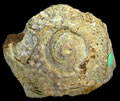The Echinoid Directory
Contributed by Jenna Sullivan, May 2007
Diplocidaris desori Wright, 1857, p. 56
| Diagnostic Features | Test large; ambulacral areas narrow and slightly flexed, with two rows of small marginal granules; poriferous zones follow the flexures of the area; the pores round, and contiguous, the septum as thick as the diameter of the pore, with a prominent tubercle on its surface; every two pairs of pores are set obliquely to each other, so that the pores of every third pair stand vertically over each other; inter-ambulacral plates large, rhomboidal, as deep as they are broad; areola large, circular; scrobicular circle complete, abutting against the poriferous zones; granules of the circle of the same size as those covering the rest of the plate; areola shallow, boss not prominent, tubercle small; miliary zone wide, with four or six rows of well-spaced-out granules. (Wright, 1857, p. 56) |
|---|---|
| Distribution | Jurassic, Aalenian or Toarcian of England, Toarcian of France. |
| Type | Holotype: Natural History Museum E1535. |
| Classification and/or Status | Species of Diplocidaris. |
| Remarks | Differs from Diplocidaris gigantea in having deeper rhomboidal plates; and the areolas and tubercles are placed closer to the poriferous zones; the ambulacral areas are likewise narrower; the pores form double oblique pairs in the zones, instead of making two distinct series as in Diplocidaris gigantea. (Wright, 1857, p. 57). Wright, T. 1857. Monograph on the British fossil Echinodermata of the Oolitic Formations. Vo. I: The Echinoidea. Palaeontographical Society Monograph. |
